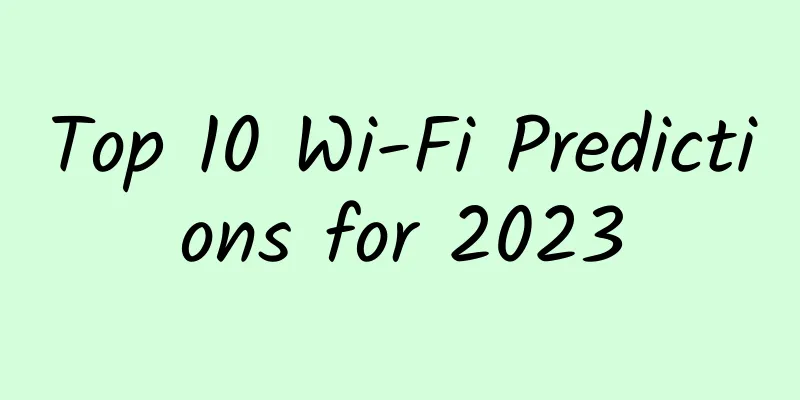Top 10 Wi-Fi Predictions for 2023

|
Christmas is around the corner, the goose is getting fatter, and telecom analysts are releasing their predictions for 2023. 2022 was a tough year for the world economy. The combined blow of Russia’s invasion of Ukraine, China’s COVID-19 lockdown, and high inflation had a profound impact on consumers and businesses. However, 2022 is going to be a good year for Wi-Fi, with more innovation, spectrum, and momentum. Let’s take a look at our top 10 predictions for Wi-Fi in 2023. Key Wi-Fi Predictions for 2023 1. Wi-Fi 6/6E continuesWi-Fi 6 has grown to an ecosystem of 500 million devices in just two years, the fastest and most successful launch in Wi-Fi history. There is no doubt that Wi-Fi 6 provides significant KPI improvements, especially high throughput, reduced latency and better performance in crowded environments. Despite the weak economic environment, many features of the Wi-Fi 6/6E standard and the ability to access additional spectrum in the 6 GHz band through the 6E extension will continue to drive widespread adoption of Wi-Fi 6/6E. Today, 55 countries, including the European Union, have opened (at least partially) the 6 GHz band for unlicensed use, and another 6 countries are currently considering it. In addition, other companies that have already adopted 6 GHz are considering expanding the range to the entire band. The huge growth in video traffic places a new burden on the capabilities required of commercial Wi-Fi networks, which will drive investment in new technologies. In most developed and developing markets, fiber broadband deployment will continue to expand, creating a need for upgrades to home Wi-Fi networks to deliver the increased bandwidth all the way to the device. 2. Wi-Fi 7 is coming earlier than expectedWi-Fi 7 is designed to use all of this newly available bandwidth, with features like 320 MHz wide channels, true multi-band/multi-radio Layer 2 carrier aggregation, and multi-AP coordination. In terms of timelines, the IEEE expects the board to ratify by May 2024, with officially standardized Wi-Fi 7 devices hitting the market from 2025 onwards. Wi-Fi 7 chipsets have been available for a few months now, with routers to follow in 2023 following announcements from TP-Link, H3C, and IO by HFCL 2022. We can also expect Wi-Fi 7 phones to be announced at Mobile World Congress in late February 2023. In 2023, we’ll see early trials of Wi-Fi 7 in different live deployment environments, with members of the Wireless Broadband Alliance being the first to do so. 3. Supply chain issuesAs backlogs shrink, we expect supply chain issues for access points and switches that began during the pandemic to persist. Global political unrest, raw material shortages, and rising fuel and energy costs are the main reasons supply chain challenges will continue in 2023. China’s recent lockdown will also increase IT supply chain uncertainty. Despite these challenges, if no major new events disrupt the supply chain again, backlogs will decrease from 5-6 months to 2-3 months and to 6 weeks by the end of 2023. 4. Open Roam™ Momentum™2022 is a good year for the Wireless Broadband Alliance's OpenRoaming program. By December 2023, the WBA expects OpenRoaming to grow from 1 million hotspots in the first quarter of 2022 to 5-6 million hotspots in various public places, covering 2,000 companies. Passpoint/OpenRoaming deployments continue to increase as more brands and identity providers recognize the value of the alliance to enable seamless connectivity access across different networks. The main obstacle to implementing Passpoint or OpenRoaming will be the continued shortage of IT resources in these organizations. On the technical side, WBA will release version 4, which will include federated login services (profile management and interfaces), network real-time QoS, custom SLAs, membership services (analytics and reporting), compliance tools and automation, and Capport (captive portal) user engagement. 5. TIP Open WiFiWith Meta cutting about 13% of its staff and moving away from connectivity, the short-term impact on the TIP OpenWiFi roadmap is likely to be negative. But in the long run, the rest of the community will take a more active role. TIP OpenWiFi has a new leader: Meta's Jack Raynor, who says, "Meta continues to support OpenWiFi and is assisting with the project's transition to the community. Because of this, and all the core development and testing resources still being invested, OpenWiFi will not lose a step from a code release and testing perspective." While there are still many questions about the level of support Meta will continue to provide, testing and R&D remain ongoing. TIP OpenWiFi will focus its R&D in 2023 on multiple areas such as production deployment of existing OpenWiFi 6E devices, OpenAFC integration, BLE/IoT support for the new Matter interface, etc. There are currently 35 customer trials in various stages of progress, and we expect some of them to turn into large commercial deployments in the first quarter of 2023. Supply chain challenges from traditional AP vendors are another driver for TIP OpenWiFi interoperable AP vendors. 6. AFCSpectrum Database Solution “Automatic Frequency Coordinator” (AFC) is required for 6GHz outdoor and high-power indoor applications. Globally, unlicensed use of the 6GHz band will continue to grow and more regulators will initiate their AFC procedures. At the time of writing, the FCC has approved 13 agencies to operate AFC services, and the number of commercial devices with Wi-Fi-6e capabilities has reached 1,095. We expect AFC to continue to gain momentum in 2023, with more access points and devices supporting 6E. It is expected that regulators in some countries such as the United States and Canada will approve the first AFC operators and the first standard power access points will be put on the market. Other countries, such as Brazil and Europe, continue to make progress in developing regulatory rules for the operation of AFC systems. The Open AFC Software Group is a dedicated, open-source community for the design, development, testing, and potential certification of AFC software for unauthorized service. 7. Convergence of Wi-Fi and 5GConvergence and coexistence are always on our radar as use cases emerge that work optimally across multiple connection types. Convergence between licensed and unlicensed technologies will continue to play a key role in service providers’ current and future strategies. There is a particular agreement focused on convergence in enterprise environments, with many stakeholders believing that Wi-Fi and 5G will coexist to support enhanced enterprise service flexibility. In 2023, enterprise campuses will continue to deploy Wi-Fi 6 and 6E, and there will be more pilot projects in industrial environments that will coexist with some private 5G networks. Wi-Fi 6/6E and OpenRoaming, as well as QoS and policies with ATSSS, will provide opportunities for 5G, private cellular, and Wi-Fi operators to further converge HetNets. 8. HaLowHaLow is a technology that uses the IEEE 802.11ah standard. The Wi-Fi Alliance calls it "Wi-Fi HaLow." The advantage of HaLow is that it operates in the sub-GHz radio frequency range (902MHz-926MHz) - much lower than traditional Wi-Fi (2.4 GHz) - and uses narrower channels than traditional Wi-Fi. The WiFi Alliance didn't certify the Wi-Fi HaLow standard until October 2021, even though the technology had been in development for six years by then. Morse Micro, Newracom, and Taixan Semiconductor currently offer HaLow chips. Morse Micro has secured A$140 million ($94.4 million) in Series B funding, which will provide it with much-needed financial support in the competitive IoT wireless market. HaLow looks more suitable for indoors (smart homes) and perhaps for campus coverage, where other types of Wi-Fi are already well-established. It remains to be seen whether it can challenge LPWAN protocols for outdoor applications that only require low bit rates, such as smart metering and environmental monitoring. 9. MetaverseGiven that much of the Metaverse will occur indoors, Wi-Fi will play a major role, emphasizing the importance of the 6 GHz spectrum and driving the need for Wi-Fi 6E, Wi-Fi 7, and beyond. The Metaverse requires predictable and consistent low latency, low jitter, and very high throughput to support both local and wireless level presence—features that next-generation Wi-Fi delivers. Various analysts predict that 2030 will be the year of the “Metaverse.” No doubt, 2023 will see more operators developing Metaverse strategies, and AR/VR devices and applications will continue to permeate our daily lives. 10. Wi-Fi ProfitsAll data traffic and innovation need to be monetized effectively. In recent years, more and more operators have successfully adopted multiple monetization strategies based on the same network and traffic. The three most prominent monetization strategies in the coming year will be marketing and analytics, cellular traffic offload services, and location-based services. However, the availability of equipment and integration with licensed spectrum networks will remain major obstacles. |
<<: What exactly is a socket? Do you want to know?
Recommend
Simplifying enterprise operations and maintenance: the right network automation strategy is key
[51CTO.com original article] From the development...
Taming your WAN: Applying SDN to the WAN
The network should respond to the needs of users ...
In the era of cloud computing, there are three network factors that enterprises cannot ignore!
In the era of distributed interconnected cloud ho...
Multi-access Edge Computing – Part 3: 5 ways to use MEC in the near future
Review the above: Multi-access Edge Computing – P...
The role of LoRaWAN and IoT in optimizing asset management
The role of the Internet of Things (IoT) and LoRa...
RAKsmart VPS 35% off, starting from $0.99/month, cloud server 30% off, starting from $1.99/month, Hong Kong/Japan/Singapore/Korea/US data centers
RAKsmart continued to offer hot flash sales for V...
How will operators charge in the 5G era? IT leaders say...
2019 is the first year of 5G commercialization. S...
TCP is not that difficult, right? This is a must-read
[[242081]] Munich, 2013 Nowadays, many programmer...
Italian media: 5G will bring 210 billion euros in revenue to Europe
According to the latest research by research firm...
Open source enthusiasts: Windows will be abandoned by Microsoft and become a Linux subsystem
[[344411]] Open source software enthusiast Eric S...
What are the differences between 802.11ax and 802.11ac Wi-Fi standards? Learn more in one article
In previous articles, we have introduced the orig...
Will RCS, which Google is pushing so hard, replace SMS? What can it do?
Google Messages uses the RCS protocol, which has ...
Ministry of Industry and Information Technology: Cancellation of data "roaming" fees will be implemented as scheduled in 2018
The State Council executive meeting on April 4 cl...
What is Wi-Fi 7, how will it enhance connectivity, and which devices will be available?
Wi-Fi 7 is the latest generation and will be stan...
How to use gdb to accurately locate deadlock problems in multithreading
[[337631]] This article is reprinted from the WeC...









